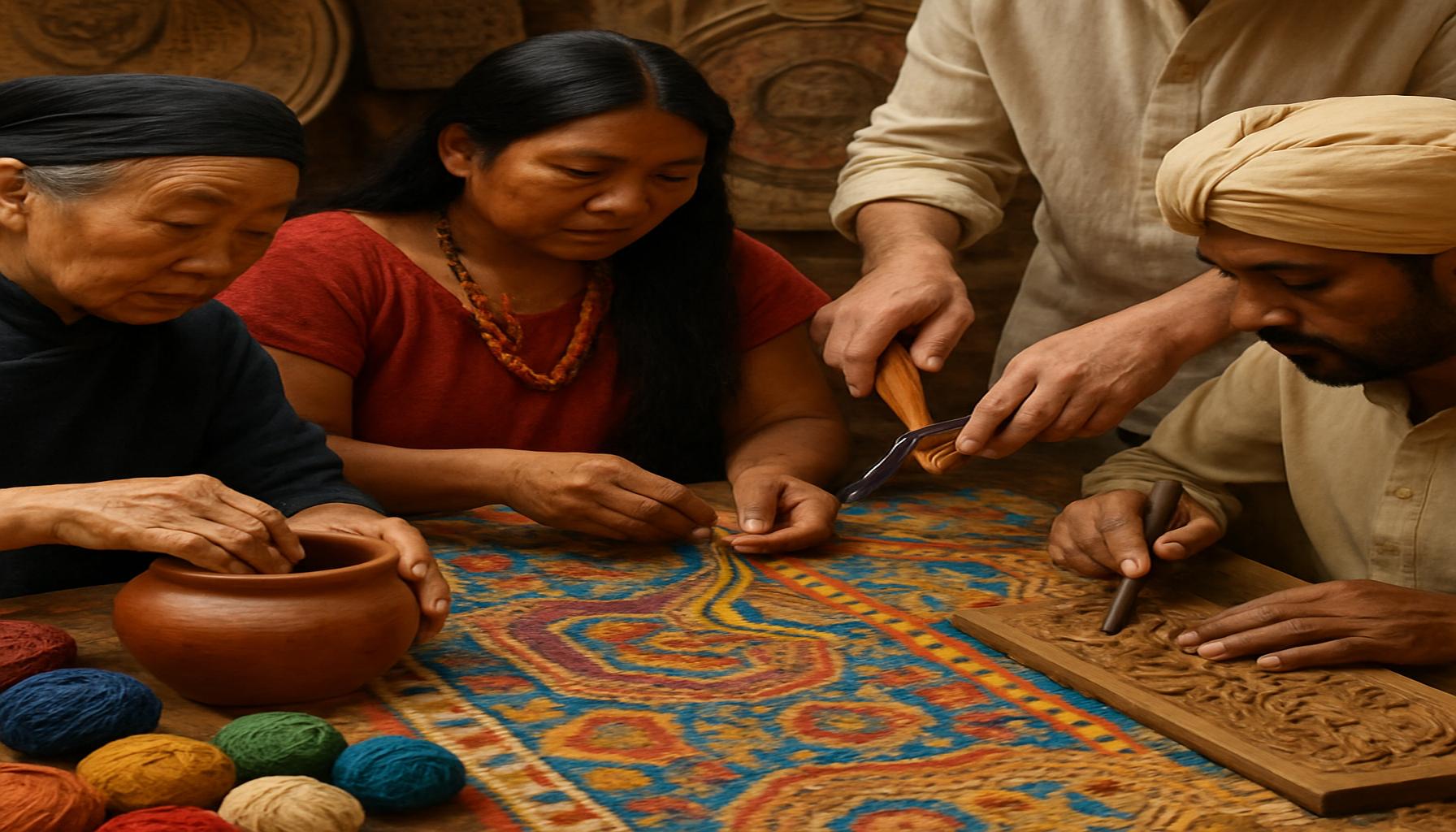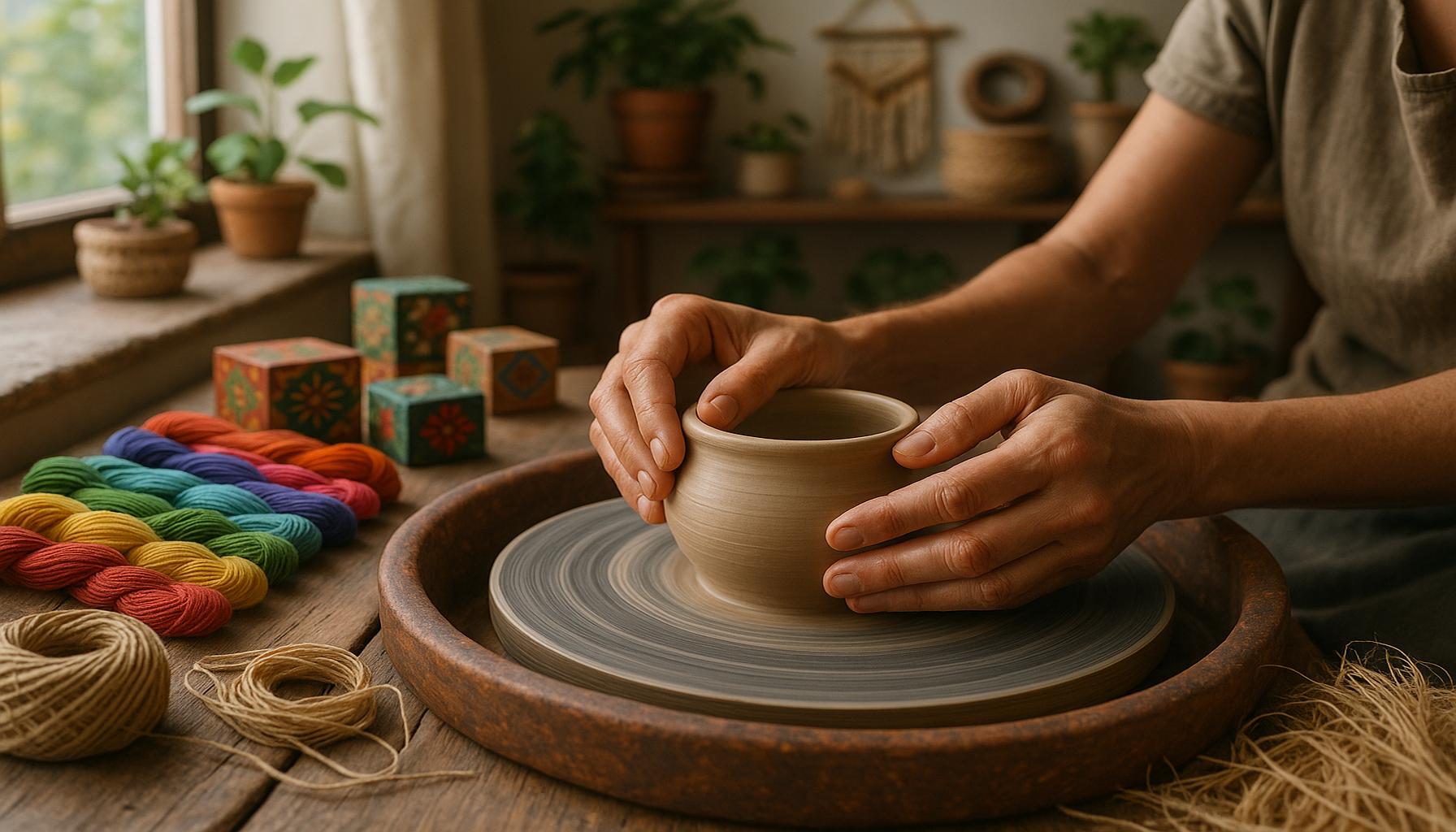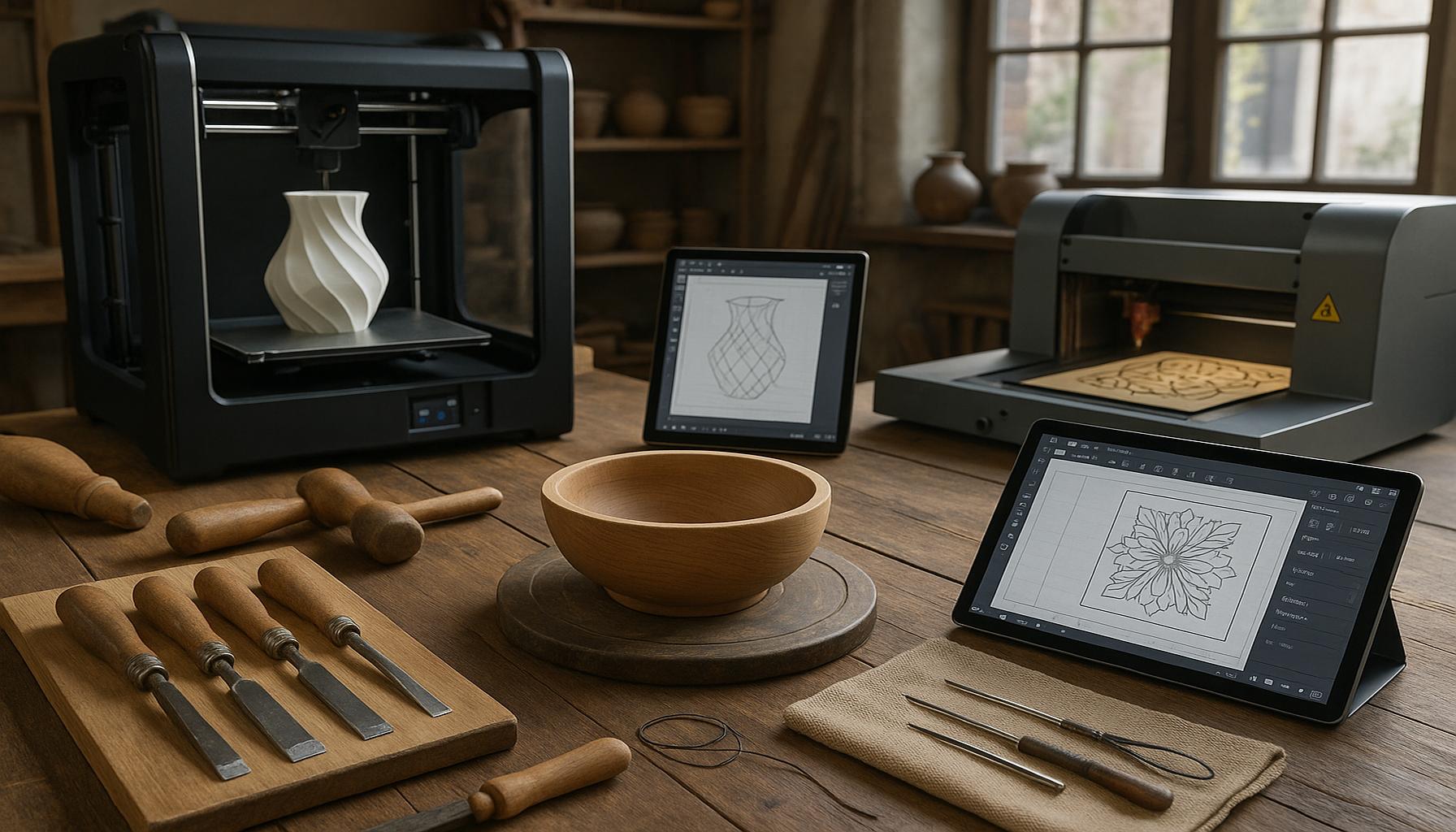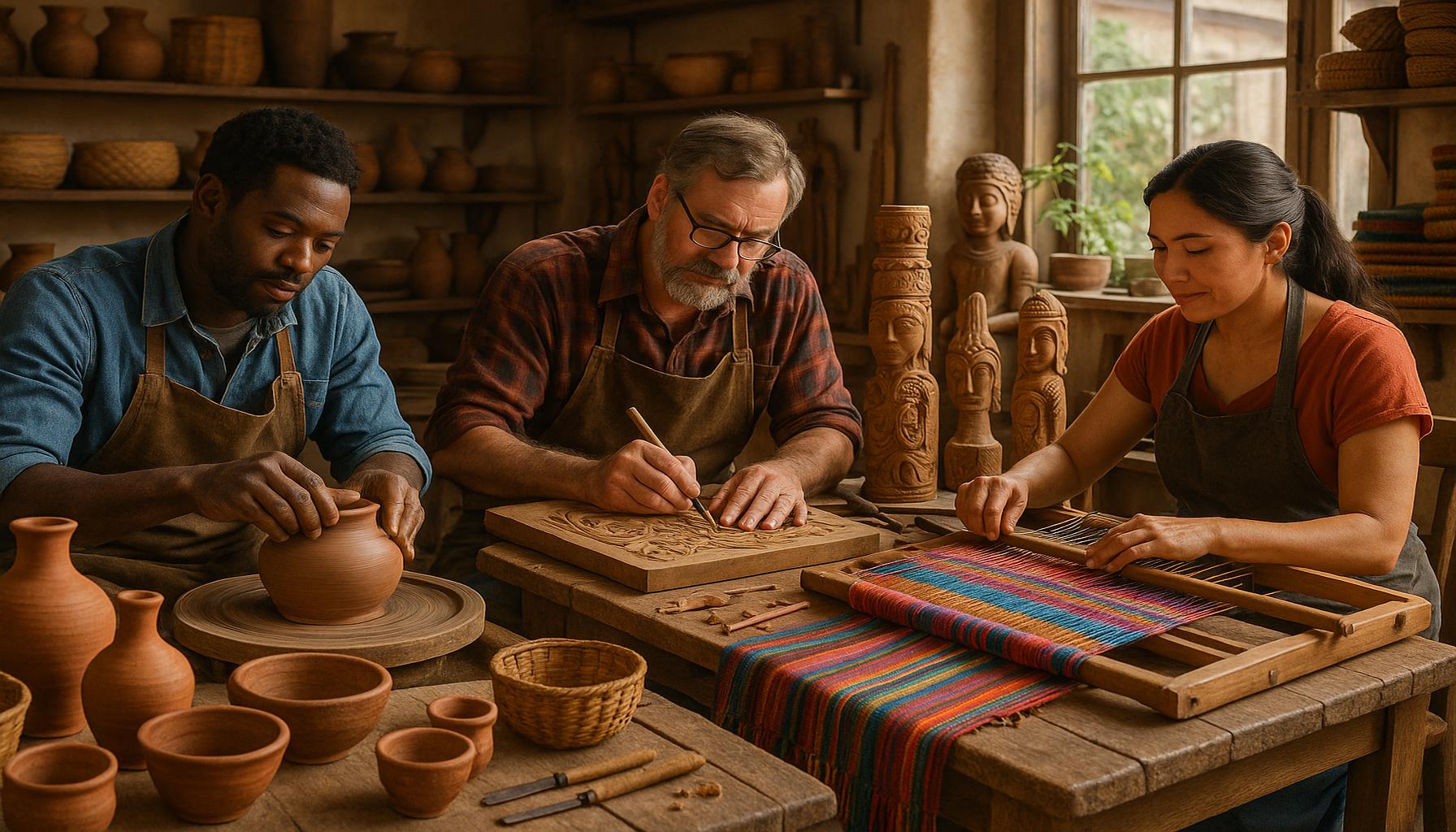Intercultural Crafts: How Different Traditions and Techniques Are Coming Together to Create New Forms of Art

The Intersection of Cultures in Craftsmanship
The evolution of crafts is increasingly marked by a remarkable synergy between traditional techniques and contemporary cultural expressions. Intercultural crafts serve as a vital link that interweaves the narratives of diverse societies, forming a rich tapestry that reflects the myriad experiences of our global community.
This fusion of craft practices is not just a random amalgamation; it is a deliberate exploration that often infuses elements of personal and collective history into artistic expressions. For example, consider a handwoven tapestry that integrates vibrant Native American motifs—characteristic of their connection to nature—with intricate patterns from African textile techniques, known for their bold colors and dynamic designs. Such a piece transcends mere aesthetics; it tells a story of cultural dialogue and shared human experience.
Advent of Innovative Techniques
As artists navigate the expansive realms of their creative practices, the willingness to experiment becomes paramount. Innovative techniques are emerging, as crafting communities blend pottery styles influenced by ancient Asian ceramics, renowned for their delicate forms and textures, with Mediterranean glazing methods that showcase a dazzling array of color. This alludes to a greater trend where artisans are not confined by geographical boundaries but are inspired by the world around them, resulting in unique works that resonate with a broad audience.
Each of these pieces carries deep cultural significance, as they are steeped in the traditions from which they are born while simultaneously promoting universal connections. The impact is felt in local communities, where the admiration of such artistry fosters respect and appreciation for diverse cultures. For instance, urban art collectives in New York City are not only vibrant hubs of creativity but also spaces where cultural exchange flourishes. Here, artists from various backgrounds perform collaborative projects that challenge the conventional boundaries of street art, illustrating how inclusion can stimulate innovation.
Craft Traditions in Artisan Markets
Artisan markets, like those in Santa Fe, are another testament to this cultural confluence. Vendors often showcase work that reflects a variety of global influences, allowing visitors to engage with handcrafted items that embody a unique blend of styles and techniques. The market becomes a multifaceted exhibition where each item, be it jewelry, ceramics, or textiles, conveys stories of tradition, adaptation, and artistic exploration.
Ultimately, the evolving landscape of craft traditions invites us to engage with a broader spectrum of artistry while embracing the narratives behind each piece. By recognizing these dynamic intersections, we unearth a vibrant tapestry of creativity that not only illustrates our diverse identities but also champions the importance of cultural dialogue in fostering understanding and appreciation across communities.
DIVE DEEPER: Click here to discover the magic of eco-friendly art
Crafting Cross-Cultural Narratives
The craft sector serves as a mirror reflecting the complexities of our interconnected world. In the realm of intercultural crafts, artisans draw inspiration from an array of cultural motifs, techniques, and practices, resulting in pieces that transcend their original context. This artistic dialogue not only celebrates diversity but also invites collaboration that enriches each artist’s creative output.
Take, for instance, the growing trend of collaborative art installations that emerge in urban settings. Artists are coming together to create monumental pieces that combine elements from their various backgrounds, often resulting in works that challenge preconceived notions about art and identity. In cities like Los Angeles and Chicago, community mural projects see participants from Latino, African American, Asian, and Indigenous cultures collaborating on vibrant murals that reflect both individual stories and collective heritage. These pieces become landmarks, capturing the history and evolution of the neighborhoods they inhabit.
Exploring Global Trends
Globalization has undoubtedly reshaped how we perceive and practice arts and crafts. As information travels instantly across borders, artists gain access to a wealth of traditional techniques that they can reinterpret and innovate upon. Here are some captivating examples of current trends in intercultural craftsmanship:
- Mixed Media Art: Artists are blending various materials and forms. For example, contemporary Native American artists may incorporate reclaimed materials like metal or plastic into ceramics, merging cultural storytelling with sustainability.
- Fusion Jewelry: Jewelers are experimenting with diverse materials—such as combining traditional silversmithing from the Southwest with colorful beadwork inspired by African art—resulting in wearable pieces that tell powerful stories.
- Textile Weaving Techniques: Numerous crafters are adopting weaving methods from both Eastern and Western techniques, creating textiles that showcase intricate patterns while also introducing new color palettes, often reflecting urban environments.
Each of these trends represents more than just a blending of styles; they evoke a sense of unity and understanding among disparate communities, showcasing how traditions can be respected while simultaneously evolving. Furthermore, these intercultural endeavors have broadened the appeal of handcrafted items, making them more sought after in both local and international markets.
As consumers become increasingly aware of the stories behind the crafts they purchase, the demand for authentic pieces that reflect genuine cultural exchanges rises. This creates a unique opportunity for artisans to not only market their work but also to engage their audiences in meaningful conversations about the significance of cultural heritage and shared narratives.
Through this lens, interconnectivity through craft becomes a celebrated medium of expression that bridges gaps between cultures and ignites curiosity about our collective histories. Embracing the intercultural craftsmanship revolution not only honors traditional methods but also fosters an enriching dialog that resonates across varied communities, proving that art can indeed serve as a universal language.
Intercultural crafts serve as a fascinating testament to human creativity, melding diverse traditions and techniques into stunning new forms of art. This artistic conversation transcends geographical barriers, allowing artisans from different backgrounds to exchange ideas and methods. The result is a vibrant tapestry of cultural expressions that reflect not only uniqueness but also shared human experiences.One striking example is the fusion of African beadwork and Japanese origami. This collaboration has led to innovative designs that incorporate the structural qualities of origami with the vibrant colors and intricate patterns typical of African crafts. The outcome is a harmonious blend that captures the essence of both cultures, resulting in striking art pieces that tell powerful stories.Moreover, the revival of ancient techniques, such as the indigenous weaving methods from the Andes in conjunction with modern textile technology, showcases how tradition can meet innovation. Artists are exploring sustainable practices by utilizing traditional materials alongside eco-friendly techniques, paving the way for responsible art-making. Such intercultural collaborations not only provide financial support for local artisans but also foster appreciation and understanding of global cultures. When diverse art forms converge, they create innovative styles that inspire future generations of artists and enthusiasts alike.To illustrate the advantages of such fusion crafts, consider the following table:
| Cultural Exchange | Innovation in Design |
|---|---|
| Diverse Techniques | New Aesthetic Values |
| Shared Stories | Blending of Cultures |
In summary, the realm of intercultural crafts not only enriches artistic expression but also offers insights into the profound connections among various cultures. Each piece is more than mere decor; it is a narrative that speaks to the heart of our shared humanity, inviting others to explore and appreciate the diverse world of art that emerges from collaboration.
DISCOVER MORE: Click here to learn about creating inspiring art at home
Revitalizing Traditions for Contemporary Contexts
As artists merge their cultural heritage with modern practices, they breathe new life into traditional crafts, making them relevant for contemporary audiences. The challenge lies not only in preserving ancient techniques but also in adapting them for today’s context. Artisans across the globe are finding innovative ways to revitalize their crafts, ensuring that they resonate with an emerging generation of consumers eager for authenticity and meaning.
This revitalization can be seen in the world of glass art, where craftspeople are blending traditional methods such as Venetian glass blowing with modern techniques like kiln-forming. Artists from varied backgrounds experiment with color and form, creating vibrant pieces that not only reflect their cultural influences but also push the boundaries of what glass art can be. These innovative products are increasingly displayed in contemporary art galleries, challenging the perception of glass as merely functional and inviting audiences to engage with its artistic potential.
Pottery also demonstrates a unique synergy of tradition and innovation. In a growing trend, potters are incorporating techniques from different cultures, like Japanese raku and Native American pit firing, resulting in pieces that echo stories from multiple origins. These collaborations often lead to workshops that invite community participation, allowing individuals to share their own stories while learning about different artistic practices. Each piece becomes a collaborative narrative, showcasing the beauty of diversity in craft.
The Influence of Technology
In today’s digital age, technology serves as a catalyst for intercultural art. Artists utilize social media platforms to share their processes and outcomes, fostering a global dialogue around their work. Platforms like Instagram and Pinterest have turned into virtual galleries, where artisans can display their crafts, engage with diverse audiences, and collaborate with fellow creators worldwide. This digital exposure has also led to increased demand for artisan goods, as consumers are drawn to handcrafted items that tell a story and speak to their values.
Moreover, the integration of technology into traditional crafts has opened up the possibilities for hybrid art forms. For instance, 3D printing is being embraced by artisans to create unique designs that incorporate traditional patterns and forms with a modern twist. By combining the precision of technology with the warmth of hand-crafted elements, artists are crafting works that resonate with both art lovers and tech enthusiasts alike.
Empowerment Through Cultural Exchange
The rise of intercultural crafts is also empowering marginalized communities by providing them with a platform to reclaim their narratives. Artisans from historically underrepresented backgrounds now have an opportunity to share their craftsmanship with a broader audience, often through cooperative networks that emphasize fair trade and ethical sourcing. Events like craft fairs and cultural festivals in cities across the United States highlight these artisans, fostering an appreciation for the diverse influences that shape their work.
By engaging with local communities and promoting cultural exchange, these artisans not only preserve their crafts but also educate the public about their cultural significance. This exchange enriches the cultural fabric of cities, transforming public spaces into vibrant showcases of global artistry.
As we explore the realm of intercultural crafts, it becomes increasingly clear that these practices stretch beyond mere aesthetics. They serve as powerful conduits for storytelling, self-exploration, and cultural pride. The merging of various traditions and techniques not only results in aesthetic innovation but also fosters stronger bonds among communities, proving that art, in its many forms, is a vital thread that connects us all.
EXPLORE MORE: Click here to discover your unique writing style
Conclusion: Embracing the Future of Intercultural Crafts
The evolution of intercultural crafts illuminates a vibrant tapestry woven from the threads of diverse cultures, transcending boundaries and fostering unity through creativity. As artists blend traditional techniques with innovative practices, they not only breathe new life into age-old crafts but also challenge audiences to rethink the essence of art itself. This ongoing dialogue between heritage and contemporary expression is crucial for preserving cultural narratives while adapting to modern sensibilities.
In an era where technology continues to redefine the art landscape, the fusion of traditional craftsmanship with cutting-edge advancements opens new doors for artistic exploration. From the intricate designs brought to life through 3D printing to the powerful storytelling shared through social media, artisans are finding unprecedented ways to connect with global audiences. This interconnectedness enriches our understanding of different cultures and broadens our appreciation for their artistry.
Moreover, the empowerment of marginalized communities within the arts signifies a shift towards inclusivity, allowing voices that have long been overlooked to shine. By participating in this cultural exchange, both artists and consumers can contribute to a greater understanding of the narratives that shape our world today. As we appreciate the beauty and complexity of intercultural crafts, we must remain open to the stories behind them and the shared experiences that bring us closer together.
In conclusion, the future of intercultural crafts lies not only in the artistic innovations they produce but also in their ability to foster dialogue, build bridges, and celebrate the rich diversity of human experience. As we navigate this ever-evolving landscape, may we continue to support and engage with the artisans who craft not just objects, but shared cultural legacies.


